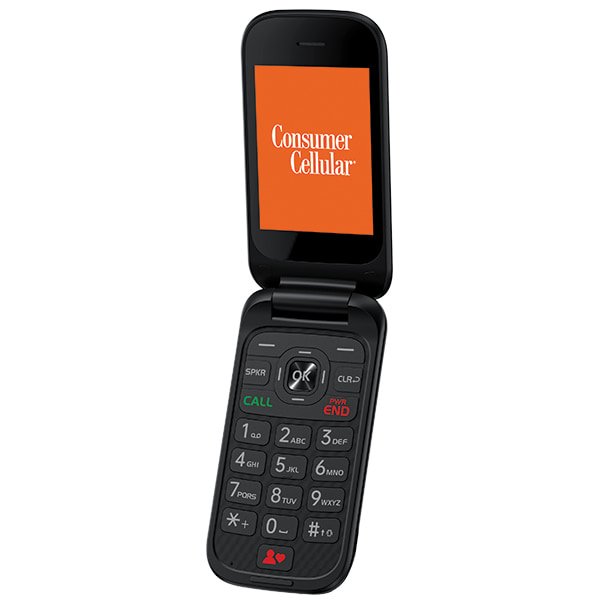[ad_1]
Ah, the digital detox—much discussed, harder to come by. In recent years, stepping away from smartphones has carried a hefty price tag and an exclusive air, from international retreats to slimmed-down devices, like Kendrick Lamar’s recent limited-edition Light 2 (which sold out in a day).
But an unlikely champion dares to ask: What if curtailing the ubiquity of the smartphone looked a little less glamorous? Less 2080, more 2008?
The Iris Flip, a new feature phone (preferred industry parlance for “dumbphone”) by Consumer Cellular is betting on it, with an unusual proposition: Maybe boomers and Zoomers really want the same thing.
Though the majority of the network’s 4 million subscribers fall into the 50-plus demographic, Craig Lister, Consumer Cellular’s chief marketing officer, describes the phone’s genesis as not only an attempt to give the company’s senior audience a friendlier phone for their needs, but also a hope that the product will reach into a big growth market—members of Gen Z, a demographic that’s yearning for disconnection.
“We’re offering it as a counterpoint,” he says. “Maybe part of the market isn’t interested in the next latest and greatest smartphone.”
Lister highlights the renaissance of the Polaroid and high-profile flip phone users like Los Angeles Rams quarterback Stetson Bennett as indicators of the phone’s viability, especially as the $69 selling point positions it as an economical option for a broad range of consumers.
Jose Briones, a “digital minimalism” content creator and moderator of the 32,000-member r/dumbphones subreddit, says that “a good percentage—like 60%—of the people that come to the subreddit are looking for a solution to smartphone dependency.”

[Photo: Consumer Cellular]
Beyond people who embrace feature phones as their daily-use device, Lister says the Iris Flip could also function as a secondary phone for some smartphone users—a weekend phone to cut out distractions.
“We actually see this as a plus one, where we don’t expect that generation to jettison their smartphone,” Lister says. “Given the low cost of service, it’s possible that they might choose it as an additional phone . . . when they want to enjoy social settings.”
Briones says such a use case isn’t unheard of among people who need smartphones for work. “It’s a good weekend phone,” he says. “It has a QR code and a browser when you’re in a pinch, but it doesn’t have all the other distracting things.”
Thoughtful choices in the “features” of the feature phone pave the way for day-to-day usability: Lister cites speech-to-text capabilities as an essential component for both older and younger users.
While the physical interface reads low-tech, the Iris Flip includes a few components that help it punch above its weight class. Among them is the use of an eSIM card rather than a physical one, which is rarely available in a phone of this price point. Essentially, the eSIM is what would allow someone to unite their smart and dumb devices under one phone number, moving fluidly between phones without discontinuity between their messages and contacts (for reference, it’s a feature that first came to Apple Watch and iPhones in 2017).
Combined with a boosted RAM for speedier processing power, the technology inside the humble shell positions the Iris as ahead of the herd.
Perhaps, gauging the rock-bottom sex appeal of terms like “RAM” and “eSIM,” Consumer Cellular’s Iris marketing approach has focused on another, more familiar feature: the camera.
Touting a “Shot on Flip” campaign, the Iris leans heavily into the yen for camera phones that the iPhone inspired, while also ostentatiously snubbing the high pixel count. The “all the phone you need” tagline could be accurately translated as “good enough,” which is more or less on the money.
Lister is excited about the authentic nature of the photos—like a Polaroid, the Iris “allows you to go out and take really spontaneous images,” he gushed. “They’re very raw and very grainy.”
The camera is . . . fine. But with apologies to the Shot on Flip’s aggressive tagline (“Bye bye social media, hi hi social life”), rather than capturing a night out, it’s more likely to be used to snap a receipt or grocery list.
As for apps? The Iris piggybacks on the Android-based KaiOS app store, which offers a mixed bag of simple applications—from utility (calculator, maps) to head-scratching (numerology) to classics that marry the old and the new (flickering candle). A podcast app rounds out the bunch to cover all the bases.
“Out of all the devices I’ve had with the KaiOS—I think this is my eighth or ninth—this is the best one,” Briones says. But will it drive the masses over to Consumer Cellular? Without support for apps like WhatsApp or other international messaging components, “I don’t know if the Iris Flip is the one,” he says.
Which doesn’t spell all bad news, depending on where you’re standing. The Iris might enter Briones’ daily rotation—just as soon as he can unlock it from Consumer Cellular’s network and move it over to his current cell carrier.
[ad_2]
Source link

